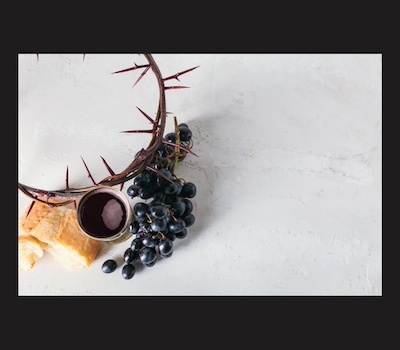 Click here to read the original pdf-formatted version
Click here to read the original pdf-formatted version
This week the Easter celebrations began. For some, the celebrations will end with Easter Monday, and for others with a liver attack.
Book of Bertil 28.01
Preamble:
This is a very religious moment for some, and for other agnostics, it’s a celebration not as pagan as it may seem. I therefore invite you to discover in a holistic procession the universe of man with its ambiguities, its beliefs and its ancestral sacrificial practices related to the Spring solstice. Bread, Wine, Lamb or Easter Ham, and tribal chocolate celebrations.
In England, as well as here in the United States, Pâques is called "Easter", in reference to the goddess Eostre, deity of fertility and renewal. She was always accompanied by her sacred hare. So, it's the hare that brings the chocolate eggs for Easter, while in Europe it's the bells.
CHAPTER 1.0
28.1.1 Eschatology...“Pâques” Traditions
This is the doctrine of last things in the monotheistic religions. It was originally a Western term, referring to Jewish, Christian, and Muslim beliefs about the end of history, the resurrection of the dead, the Last Judgment, the Messianic era, and the problem of theodicy (the justification of God's righteousness).
In Western societies, religious temporality has imposed a linear model on social time, largely dependent on Judeo-Christian eschatological traditions, the product of a slow elaboration forged from various influences, including that of Zoroastrianism, the source of ancient pagan practices. This perception of a univocal time is built on a paradox by linking this continuous progression to an enactment of the eschatological process by means of rites inscribed in the cyclical periodization of the calendar. This ritual-based updating of the myths that underlie it thus forces the present, the past and the future to come together periodically in celebration, such as that of the spring solstice.
28.1.2 Pascha
From the Christian Latin Pascha "the Jewish Passover", borrowed from the Greek paska, itself derived from the biblical Hebrew pesah "Passover", from the verb pesah, pesach "to go ahead to spare". The Passover was created by Moses (New Testament) to commemorate the exodus of the Jews from Egypt, the end of slavery and the crossing of the Red Sea. Easter was therefore a Jewish holiday before becoming a Christian holiday that celebrates the transition from winter (darkness, misery) to that of renewal (liberation, rebirth). This celebration is also found in several forms in Persian beliefs (Iran) with the celebrations of Nowruz (New Year) and in the Orthodox Christian Church, including those in Jerusalem, Egypt, Greece, Russia, Serbia, and Ukraine, which use the Julian calendar, which is based on the period of the earth's revolution around the sun and was widely used in the Western world before the sixteenth century.
"He who has enough to eat today and wonders what he will eat tomorrow is a man of little faith," says the Talmud.
CHAPTER 2.0
28.2.1 Bread
Bread is humankind’s main means of subsistence. It is mentioned at the beginning of Genesis: "By the sweat of your face you shall earn your bread" (Gen 3:19). Above all, it is meant to be shared with others, especially the hungry. Its presence or absence is a sign of divine blessing or, on the contrary, of punishment for sin. The righteous man is called to ask God for his "daily bread" (Mt 6:11), and to wait for it with confidence, like the manna from heaven that fed the people in the desert every day (Ex 16).
It is during the multiplication of the loaves, carried out by the prophet Elisha and then by Jesus, that God satisfies his people and testifies to his superabundant love. Bread is therefore at the epicenter of Easter celebrations. Originally a flat bread, it became larger and richer with the abundance of yeast natural in the West (sourdough) and then became the Easter brioche in Christendom. Hot cross buns remain the traditional English Good Friday pastry. These candied fruit buns spiced with cinnamon, ginger and sometimes nutmeg are usually eaten hot, halved, and spread with butter. Their origin dates to long before the Christian era: in pagan times, to celebrate the vernal equinox. Cupcakes were offered to Eostre, the Saxon goddess of fertility. The sign of the cross, whose symbolism is now linked to Christianity, represented, at that time, the four quarters of the moon. Later, the Church built on these ancient beliefs and adapted them by associating them with the design of the cross of Christ. As for the French Easter Brioche, its origin dates to the 2nd century BC with the prohibition of eating eggs or dairy products during Lent (40 days). So, the brioche was a way to use the eggs that weren’t consumed during this period of fasting. This tradition is also found with bread without yeast in the Hebrew religion with Matzoh during the celebration of the Passover.
28.2.2 The Wine
Easter, celebrated around the world, is a time of ancient traditions and deep meanings. At the heart of this holiday are various symbols, but none are as ubiquitous as wine, often accompanying the festive Easter meal. The links between wine and Easter date back to ancient times. A symbol of life and celebration, wine was associated with religious celebrations, from which the Last Supper of Jesus with his disciples was inspired. In the Christian tradition, wine takes on an even deeper meaning during Easter Mass, symbolizing the blood of Christ. In Hebrew, each letter of the alphabet has a numerical value. By adding up the letters of a word, we get a total. In this way, two words that have the same numerical value can resonate. This method is called gamatria. For example, the word "wine" (yayin) has a numerical value of 70, the same as the word "secret" (sod). Applying gamatria to certain words of the Gospel (even if they were written in Greek) can renew their meaning. The miracle of the transformation of water into wine at the wedding feast at Cana is interpreted in the Christian tradition as the union of God with his people and of Jesus with humanity. "When drinking, one might say, the wine goes in and the secret goes out. In other words, Jesus, through this new wine, reveals the secret of things." In Judaism, during the holiday of Pesach (Passover), the blessing of the seder is recited and each person must drink 4 cups of wine to commemorate the liberation of the Jewish people from slavery in Egypt.

Additamentum
28.A.1 Ancestral pagan origin.
But there is still an ancestral pagan origin connected to religious traditions. Wine refers to ancient practices whereby the year's wine (the previous year's harvest) is not consumed before the spring solstice. This allowed the red wine to carry out a second fermentation, known as malolactic, which gives suppleness, roundness, and microbiological serenity to the wines, as well as avoiding fermentation in the bottle which can make the wine unstable. It was believed that spirits, moving from the world of darkness to scientific clarity, understood that only the weather, marked by Easter, guaranteed peace for wine. For the same reason, fine wines are kept in barrels for 12 months after their malolactic fermentation to mature. Thus, ancestral traditions dictate that fine wines are tasted and pre-sold only after Easter. (18 months after the harvest). It was therefore fitting in the tradition that the nobles should give wine as an offering to the less fortunate to be shared by all. What remains in the tradition today of making good wines to share for the Easter celebration.
"When the LORD shall pass by to smite Egypt, and shall see the blood on the lintel and on the two posts, the LORD shall pass over the gate, and he will not allow the destroyer to enter into your houses to strike" (Exodus 12:23)
28.2.3 Lamb or Ham
In addition to wine, several dishes are emblematic of the celebration of Easter around the world. Among them, the leg of lamb occupies a central place. This dish, often associated with red wine, symbolizes the sacrifice of the Lamb of God in the Christian tradition, and has its roots in the Passover sacrifice of the Passover lamb. In Jewish tradition, on this day the fat sheep was killed and eaten by the family. This is to remind us that to symbolize their faith, each family of the Hebrew people sacrificed a lamb before crossing the Red Sea. Passover commemorates the exodus into the wilderness, and the safeguarding of the children (the new, the young) of the Hebrew people. For the Christian until the 16th century, roasted lambs were brought into churches and blessed by the priest as the main course on Easter Day. Easter is typically the symbol of life after death. So, the lamb, which was taken up by the Christians, became the founding event of the commemoration of Christ's resurrection and the advent.

28.2.4 But what about Ham?
Until the beginning of the 20th century in the United States, sheep farming was an important industry, as wool was the main resource for the manufacture of socks, warm clothing, and blankets. But with the end of the First World War and the advent of synthetic textiles, the importance of livestock farming was drastically reduced, which led to a scarcity of lamb meat and an increase in its selling price. It was therefore necessary to find a cheaper and more abundant alternative. Spring pork was therefore the logical solution for the Pâques celebrations. Non expensive, accessible, and able to feed a large number of guests.

Chocolate Conclusion
In antiquity, there was a pagan tradition of celebrating the arrival of renewal, of the good old days, by offering painted eggs, which symbolized creation and fertility. In the 16th century, chocolate arrived in the West, and the idea came to empty the eggs preserved during Lent and fill them with chocolate. Then, from the 1830s onwards, new techniques made it possible to make a wide variety of shapes thanks to original metal molds, and to give us beautiful liver attacks.
Annotate
For my part, I wish you to celebrate this moment of life, of the renewal of nature and of hope for peace, putting aside our differences to come together as the people of the world around the table of sharing and to celebrate a land that will once again be generous and abundant.
Mr.B
*Memorandum: My words and opinions in these newsletters are and would always be personal, and I intend to offend. I always accept that others have the full right and duty to challenge me, to argue, and, if it is necessary, excommunicate me from their beliefs (often dull and hollow) because I would act the same way if it were the other way around.


 Click here to read the original pdf-formatted version
Click here to read the original pdf-formatted version

